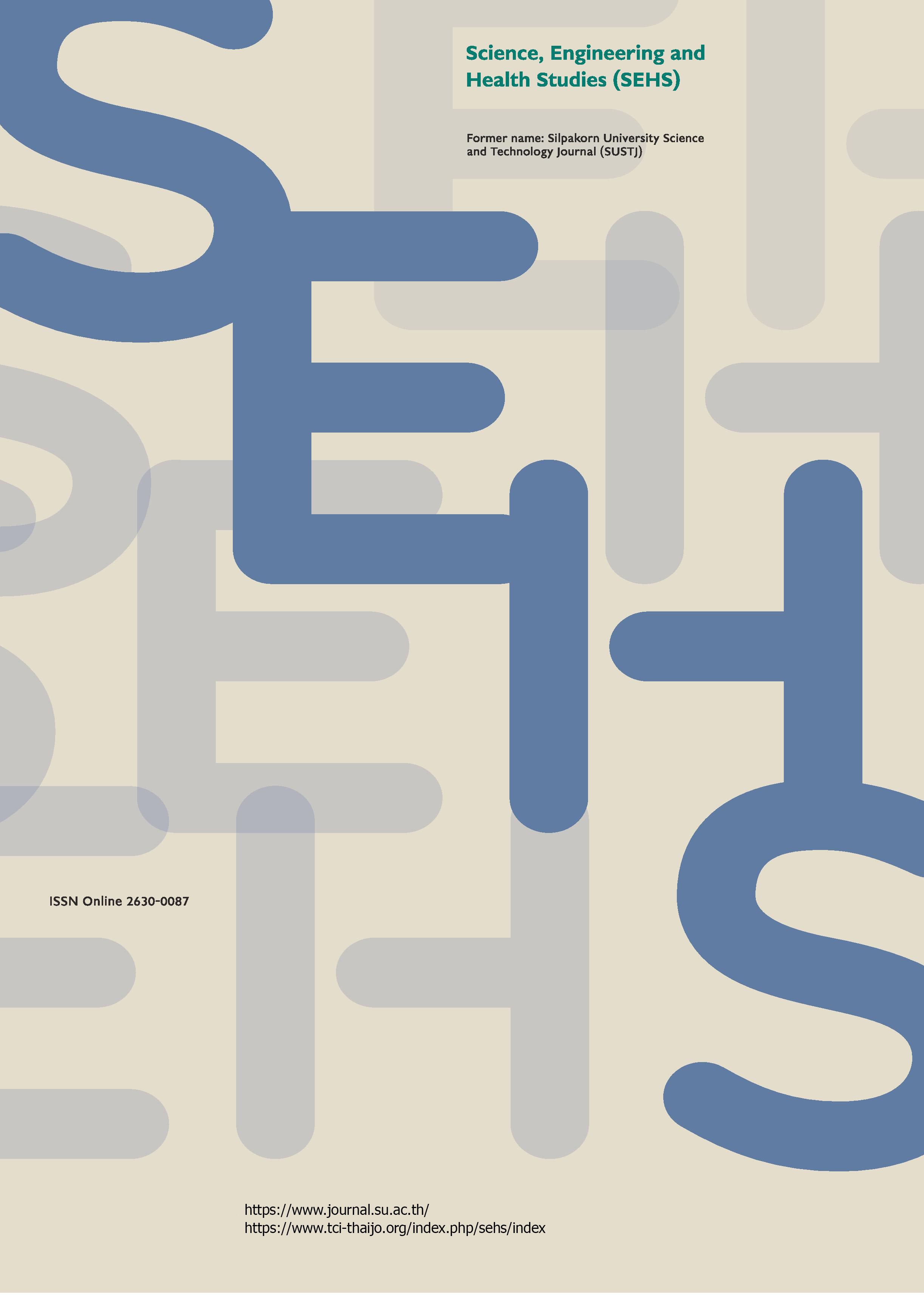Stability study of blue phycocyanin from spirulina and compatibility evaluation in eye remover solution using Plackett-Burman design
Main Article Content
Abstract
Phycocyanin is a blue pigment in spirulina that has been used as a colorant in the food, cosmetic, and pharmaceutical industries. However, it has a stability problem that is affected by numerous factors, such as light, temperature, and pH. The objectives of this study were to investigate the effects of temperature (40°C, 50°C, 60°C, 70°C, and 80°C) and pH (5.0, 6.0, 7.0, and 9.0) on phycocyanin stability. The results showed that the degradation of phycocyanin followed a first-order reaction. The maximum stability of phycocyanin was at pH 6.0 (the lowest degradation rate constant, 0.0480 h-1). An increase in temperature significantly increased the degradation rate (p < 0.05) and correlated well with an Arrhenius plot of the degradation rate (ln k) against the reciprocal of kelvin (1/T), which showed a linear regression line with an R2 value of 0.9656. The compatibility study of phycocyanin with various excipients in eye remover solution, as an example of cosmetic formulation, followed the Plackett-Burman design. The results showed that 47.0% w/w glycerin had a significant destabilizing effect on phycocyanin stability. These results indicate that a pH of 6.0 and lower temperatures increase the stability of phycocyanin.
Downloads
Article Details

This work is licensed under a Creative Commons Attribution-NonCommercial-NoDerivatives 4.0 International License.
References
Adjali, A., Clarot, I., Chen, Z., Marchioni, E., and Boudier, A. (2022). Physicochemical degradation of phycocyanin and means to improve its stability: A short review. Journal of Pharmaceutical Analysis, 12(3), 406–414.
Antelo, F. S., Costa, J. A. V., and Kalil, S. J. (2008). Thermal degradation kinetics of the phycocyanin from Spirulina platensis. Biochemical Engineering Journal, 41(1), 43–47.
Böcker, L., Ortmann, S., Surber, J., Leeb, E., Reineke, K., and Mathys, A. (2019). Biphasic short time heat degradation of the blue microalgae protein phycocyanin from Arthrospira platensis. Innovative Food Science and Emerging Technologies, 52, 116–121.
Braham, S. A., Siar, E. H., Arana-Pena, S., Bavandi, H., Carballares, D., Morellon-Sterling, R., Andrades, D., Kornecki, J. F., and Fernandez-Lafuente, R. (2021). Positive effect of glycerol on the stability of immobilized enzymes: Is it a universal fact? Process Biochemistry, 102, 108–121.
Carstensen, J. T. (2000). Solution kinetics. In Drug Stability: Principles and Practices (Carstensen, J. T. and Rhodes, C. T., Eds.), 3rd, pp. 19–55. New York: Marcel Dekker.
Chaiklahan, R., Chirasuwan, N., and Bunnag, B. (2012). Stability of phycocyanin extracted from spirulina sp.: Influences of temperature, pH and preservatives. Process Biochemistry, 47(4), 659–664.
Garrett, E. R. (1962). Prediction of stability of drugs and pharmaceutical preparations. Journal of Pharmaceutical Sciences, 51(9), 811–833.
Gorgich, M., Passos, M. L. C., Mata, T. M., Martins, A. A., Saraiva, M. L. M. F. S., and Caetano, N. S. (2020). Enhancing extraction and purification of phycocyanin from Arthrospira sp. with lower energy consumption. Energy Reports, 6(8), 312–318.
Hadiyanto, H., Christwardana, M., Sutanto, H., Suzery, M., Amelia, D., and Aritonang, R. F. (2018). Kinetic study on the effects of sugar addition on the thermal degradation of phycocyanin from Spirulina sp. Food Bioscience, 22, 85–90.
Jespersen, L., Strømdahl, L. D., Olsen, K., and Skibsted, L. H. (2005). Heat and light stability of three natural blue colorants for use in confectionary and beverages. European Food Research and Technology, 220, 261–266.
Li, Y., Zhang, Z., and Abbaspourrad, A. (2021). Improved thermal stability of phycocyanin under acidic conditions by forming soluble complexes with polysaccharides. Food Hydrocolloids, 119, 106852.
Sinko, P. J. (2011). Martin’s Physical Pharmacy and Pharmaceutical Sciences, 6th, Baltimore: Lippincott Williams & Wilkins, pp. 318–354.
Treesinchai, S., Pitaksuteepong, T., and Sungthongjeen, S. (2020). Determination of curcumin stability in various gastrointestinal pH by Arrhenius equation using HPLC method. Pharmaceutical Sciences Asia, 47(1), 86–96.
Martelli, G., Folli, C., Visai, L., Daglia, M., and Ferrari, D. (2014). Thermal stability improvement of blue colorant C-phycocyanin from Spirulina platensis for food industry applications. Process Biochemistry, 49(1), 154–159.
Motola, S., and Agharkar, S. N. (1992). Preformulation research of parenteral medications. In Pharmaceutical Dosage Forms: Parenteral Medications Volume 1: Formulation and Packaging (Avis, K. E., Lieberman, H. A., and Lachman, L., Eds.), 2nd, pp. 115–172. New York: Marcel Dekker.
Rowe, R. C., Sheskey, P. J., and Quinn, M. E. (2009). Handbook of Pharmaceutical Excipients, 6th, Grayslake, Illinois: Pharmaceutical Press and American Pharmacists Association, pp. 283–286.
Wu, H. L., Wang, G. H., Xiang, W. Z., Li, T., and He, H. (2016). Stability and antioxidant activity of food-grade phycocyanin isolated from spirulina platensis. International Journal of Food Properties, 19(10), 2349–2362.
Yazar, J. G., and Demiray, E. (2023). Degradation kinetics of bioactive compounds in dried mistletoe leaves during storage. Food Bioscience, 52, 102477.
Yuan, B., Li, Z., Shan, H., Dashnyam, B., Xu, X., McClements, D. J., Zhang, B., Tan, M., Wang, Z., and Cao, C. (2022). A review of recent strategies to improve the physical stability of phycocyanin. Current Research in Nutrition and Food Science, 5, 2329–2337.
Zahra, N., Kalim, I., Saeed, M., Mumtaz, Z., Amjad, N., Nisa, A., Hina, S., Masood, S., Ahmed, I., and Ashraf, M. (2017). Effect of natural and synthetic dyes on human health. International Research Journal of Biological Sciences, 6(10), 23–29.
Zhang, Z., Cho, S., Dadmohammadi, Y., Li, Y., and Abbaspourrad, A. (2021). Improvement of the storage stability of C-phycocyanin in beverages by high-pressure processing. Food Hydrocolloids, 110, 106055.


